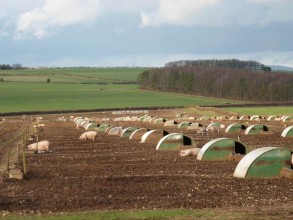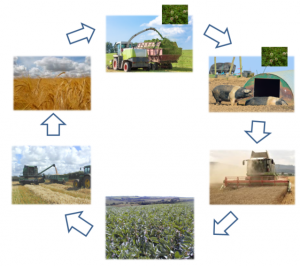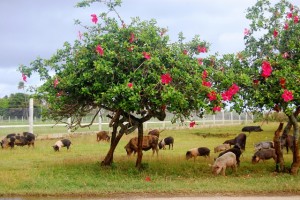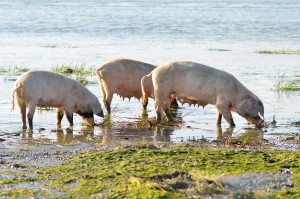Site and farm suitability

Typical outdoor commercial pig farm with potential to integrate into arable crop rotation (www.fawleyfarms.co.uk)
Our principles for sustainable livestock production places emphasis on livestock systems being land-based and integrated with farm cropping enterprises. Outdoor pig production offers a great opportunity for inclusion within a crop rotation on an arable or mixed farm or within an agro-sylvo-pastoral systems such as those found in the Dehesa in Southern and Central Spain.
Whilst the main concerns with regard to site selection are probably environmental, health and welfare considerations are also important. Overstocking with pigs for a long period on the same area can cause serious environmental problems concerned with nitrate leaching (Worthington and Danks, 1992; Danks et al., 1997) which can be alleviated by successful integration into the cropping system, where the animals are mobile and the stocking rate related to the amount of feed given and hence the potential manure produced (Andreson and Redbo, 1999).
Key Considerations
- Mild winters and moderate rainfall (below 800 mm) are climatic prerequisites for a good site, in order to avoid exposure, cold stress and unsuitable underfoot condition
- A light, free-draining soil type free of sharp stones is important in order to avoid lameness and stress and to guarantee all year round access
- Sloping ground for farrowing paddocks should be avoided, to prevent piglet deaths due to nest gravitation
- Windy sites are not necessarily inappropriate, as long as the huts are pointed out of the prevailing wind
- Wallows and shades must be provided over the summer months
- Artificial, well-bedded shade can also be used as an additional aid against heat stress
- Whilst mains electricity is not essential, a good water supply to the site must be available, to avoid animal welfare concerns with regard to adequate drinking water or the maintenance of wallows and mud baths (see paddock enrichment below) in the summer months
- Pigs must have roughage, fresh or dried fodder or silage as part of their daily ration and should have access to growing green food on the range. This latter element can be a challenge with un-ringed sows during winter months (see also Feeding).
When integrating pigs within a crop rotation, adequate access to clean ground within the crop rotation system is essential i.e. ground that has been rested for at least four years. The site and paddock rotation has to be frequent enough to prevent total destruction of ground cover and contamination of soil with pathogens.Outdoor pigs should be followed as soon as possible by a grass ley, early sown winter or spring cereals to ensure that soil protection and structure are restored and a protective crop cover is quickly established. This will ensure that the following crop is able to utilise the residual nitrogen thereby minimizing the leaching of nitrates. Typical annual nutrient loadings from outdoor pig units are about 400 kg/ha nitrogen (N) and about 200 kg/ha phosphate (P2O5).
Pig Health Outdoors
Pigs kept outdoors tend to have a relatively high health status as they are kept at low stocking density and there is hence a reduced disease challenge. On some stony soils lameness can be a problem, especially thin soils over rock and those containing flints. Damage to legs and feet can become infected. Piglets are particularly susceptible to chilling and hypothermia from wet bedding which increases their susceptibility to disease.
Stocking density and health
The number of pigs kept per unit area, or the stocking density, should at least in part be determined by the amount of manure they are likely to produce, which in turn influences the risk of nitrate leaching. Organic farming legislation in Europe requires livestock farms to have a maximum overall stocking density equivalent to an annual output of 170 kg of N/ha. The Defra (2003) Code of Recommendations for the Welfare of Livestock – Pigs recommends a maximum stocking density of 25 sows/ha at paddock level. The Soil Association recommends stocking at around two sows and their progeny per hectare of rotational ground – if the land is only used once in four years this means the effective stocking rate at any one time is eight sows and their progeny per hectare (Soil Association, 2009)

In this crop rotation example, pigs are kept on the second year of a grass-clover pasture, followed by a cereal crop (winter wheat), a legume crop such as beans, two cereal crops (e.g. winter triticale followed by spring barley) before returning in the fifth year to a grass-clover pasture used for silage production and grazing by cattle or sheep
With regard to animal health and welfare, the following stocking densities at paddock level are recommended in conventional systems: for gestation paddocks, a maximum 25 sows/ha, or less on heavier soils; for farrowing paddocks, 15-25 sows/ha. These densities are, however, for systems where sows are kept on the same site for up to 12-18 months. In a rotational, organic system, individual farrowing paddocks may be much smaller, as they are only to house one group of sows and their litters before being moved to new ground. High stocking densities will lead to disease in piglets, higher parasite burdens, leg problems, stress, aggression and wastage of feed.
Set stocking or paddock rotation?
There are two options basic options with regard to land management: set stocking or paddock rotation? Set stocking allows an allocation of land for a significant period of time e.g one year. Paddock rotation involves more frequent movement onto new pastures e.g every 3-4 months.
From a health perspective, there are two important considerations when designing a paddock system.
1. There needs to be adequate provision for site and paddock rotations to avoid loss of ground cover and contamination with pathogens and parasites.
On organic farms, the stocking density needs to be low enough to allow adequate rotation of sites and paddocks. There is a recommendation of no return to the same site within four years and maintenance of adequate ground cover and provision of clean ground for weaners and farrowing sows are essential. In conventional units, with 18-24 month site changes, roundworm burdens on the pasture at the end of the period may necessitate regular dosing with anthelmintics to control clinical problems in piglets. This is not acceptable under organic management, and pig units should move site at less than 12 month intervals.
Farrowing huts should be thoroughly cleaned, old straw should be burned, and the hut moved to a new, vegetation-covered paddock between each farrowing.
2. Low stocking densities within paddocks are important in the prevention and control of disease.
Prevention and control of the following diseases benefits from lower stocking densities: external and internal parasites, lameness, dysentery, salmonellosis, and all respiratory diseases.
During wet periods rotational paddocks may be advantageous as pigs are moved off damaged pasture, whereas pasture recovery is more difficult in a set stocked situation. In drier periods however, set-stocked paddocks maintain grass cover for longer and therefore incur less labour for moving without significant pollution risk. Set-stocked pigs also use the further portions of a field, but this may require good management to achieve satisfactory grass usage and the even distribution of excreted nutrients (ADAS, 2002).


 American English
American English



Comments are closed.